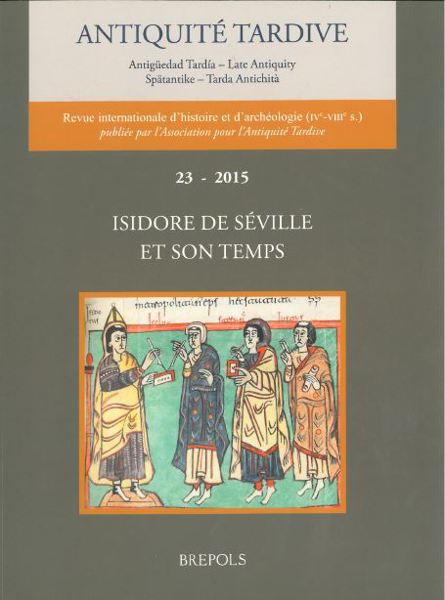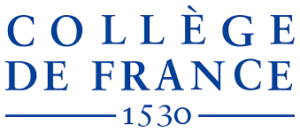Antiquité Tardive 23 (2015)

Dossier – Isidore de Séville et son temps
Resp. I. Velázquez, G. Ripoll
Isidoro de Sevilla y su época. A modo de introducción
1. Isidore, ses œuvres et la culture de son temps
C. Codoñer, La lengua de Isidoro – Isidore’s language
J. Elfassi, Connaître la bibliothèque pour connaître les sources : Isidore de Séville — To know the library in order to know the sources: Isidore of Seville
I. Velázquez, Revisiones de autor y de copistas en las obras de Isidoro de Sevilla. A propósito de la Historia Gothorum — Authorial and spurious revisions in the works of Isidore of Seville: remarks concerning the Historia Gothorum
S. Rus Rufino, Unidad y paz en el reino visigodo. Dos aspectos del pensamiento político de Isidoro de Sevilla — Unity and peace in the Visigothic Kingdom. Two aspects of the political concepts of Isidore of Seville
M. Mülke, „Isidorische Renaissance » – oder: Über die Anbahnung einer Wiedergeburt — « Isidorian Renaissance » – or About the planning of a rebirth
H. Inglebert, Isidore de Séville en son monde : lieux, peuples, époques — Isidore of Seville in his world: places, people, eras
2. Isidore et les acteurs sociaux contemporains
G. Kampers, Isidor von Sevilla und das Königtum — Isidore of Seville and the kingship
W. Pohl, P. Dörler, Isidore and the gens Gothorum — Isidore et la gens Gothorum
P. Barata Dias, L’idéal monastique, les moines et les monastères du monde wisigothique selon Isidore de Séville — The monastic ideal, monks and monasteries in the Visigothic world according to Isidore of Seville
F. J. Andrés Santos, Derecho y jurisprudencia en las fuentes de Isidoro de Sevilla — Law and jurisprudence in the legal sources of Isidore of Seville
3. La culture matérielle dans l’Hispanie d’Isidore
P. Reynolds, Material culture and the economy in the age of Saint Isidore of Seville (6th and 7th centuries) — Culture matérielle et économie à l’époque de saint Isidore de Séville (vie-viie siècles)
J. Arce, Isidoro y el paisaje rural contemporáneo (s. VII) — Isidore and the contemporary landscape
A. Arbeiter, Die Sakralarchitektur Hispaniens im „Reich von Toledo » aus der Sicht der aktuellen Forschung — The sacred architecture of Spain in the « reign of Toledo » in the light of current research
E. Carrero, D. Rico, La organización del espacio litúrgico hispánico entre los siglos VI y XI — The organisation of Hispanic liturgical space between the 6th and 11th centuries
4. L’héritage d’Isidore
E. Falque, En torno a la figura de Isidoro en el s. XIII: Lucas de Tuy — Concerning Isidore’s figure in the 13th century: Lucas of Tuy
L. F. Gallardo, Los Godos en la memoria histórica castellana del medievo — The memory of the Gothic past and Hispanic history in the Middle Age
_____________
Varia
A. Stefan, Caius Valerius Diocles. Le premier nom d’empereur de Dioclétien et la reconnaissance de son autorité en Égypte. À propos de P. Oxy. XLII 3055 et AE 1973
E. Rizos, Remarks on the logistics and infrastructure of the Annona Militaris in Eastern Mediterranean and Aegean areas M. Silver, Loans from Lords in the growth of the colonate
P. Diarte Blasco, J. M. Gurti i Esparraguera, La percepción del espacio en el urbanismo tardoantiguo: características evolutivas en el ejemplo hispano
R. Barroso Cabrera, J. Carrobles Santos, J. Morín de Pablos, I. Sánchez Ramos, El paisaje urbano de Toledo en la antigüedad tardía
G. A. E. Felle, Esporre la Scrittura. L’uso di testi biblici in epigrafi d’ambito pubblico fra Tarda Antichità e prima età bizantina (secoli IV-VIII)
E. Noce, «Quasi et ipsi nunc lapident iustos et occident prophetas»: reflexiones críticas respecto de la motivación histórica del sermo XIII de Cromacio de Aquileia
M. V. Escribano Paño, Simulación, abjuración y delación de Maniqueos en África: el testimonio de Augustín
G. D. Dunn, Zosimus‘ Synod of Rome in September 417 and his Letter to Western Bishops (Cum aduersus)
Chronique
L.G. Khrushkova, Notes on a new publication on the religious architecture of Caucasus in the 7th century
Bulletin critique




